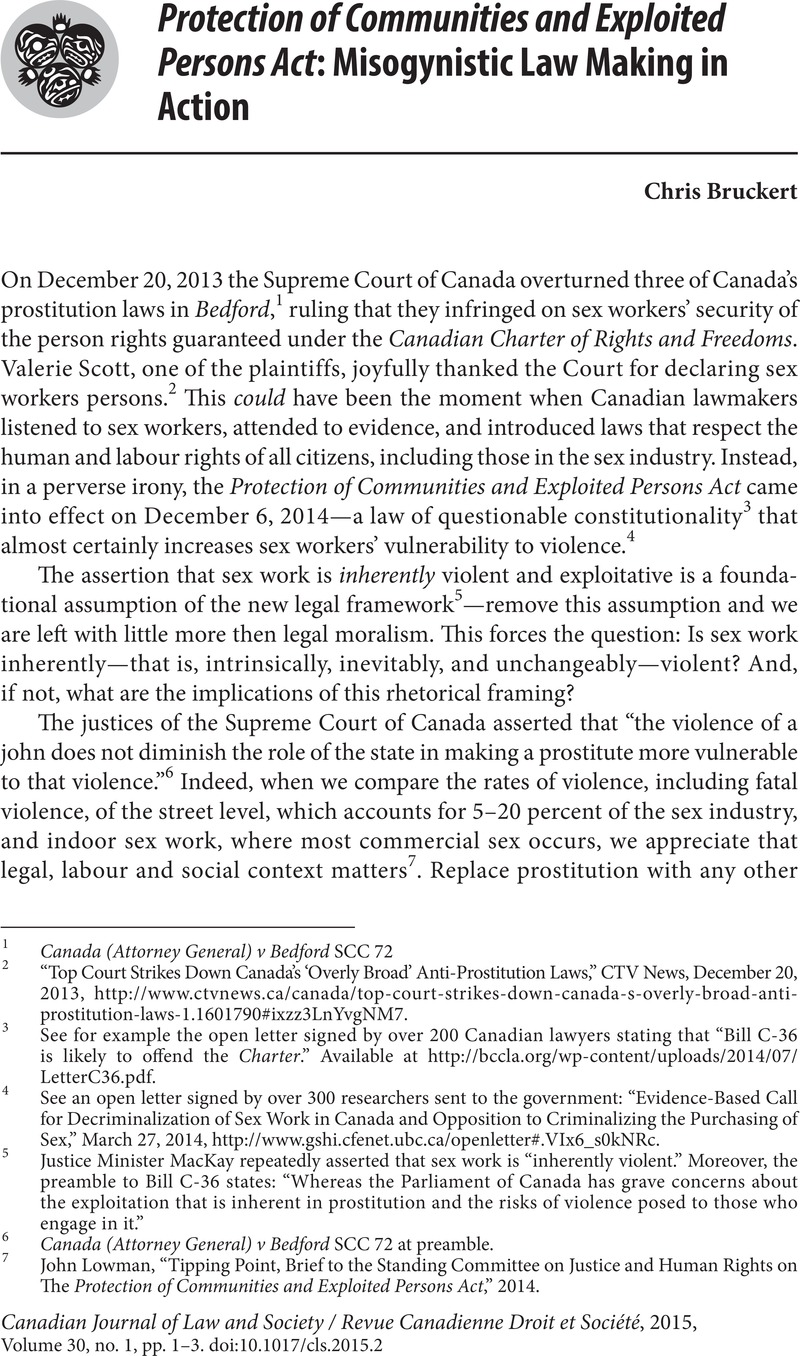Article contents
Protection of Communities and Exploited Persons Act: Misogynistic Law Making in Action
Published online by Cambridge University Press: 20 March 2015
Abstract

- Type
- Commentary: After Bedford / Commentaire: Après Bedford
- Information
- Canadian Journal of Law and Society / La Revue Canadienne Droit et Société , Volume 30 , Issue 1 , April 2015 , pp. 1 - 3
- Copyright
- Copyright © Canadian Law and Society Association / Association Canadienne Droit et Société 2015
References
1 Canada (Attorney General) v Bedford SCC 72
2 “Top Court Strikes Down Canada’s ‘Overly Broad’ Anti-Prostitution Laws,” CTV News, December 20, 2013, http://www.ctvnews.ca/canada/top-court-strikes-down-canada-s-overly-broad-anti-prostitution-laws-1.1601790#ixzz3LnYvgNM7.
3 See for example the open letter signed by over 200 Canadian lawyers stating that “Bill C-36 is likely to offend the Charter.” Available at http://bccla.org/wp-content/uploads/2014/07/LetterC36.pdf.
4 See an open letter signed by over 300 researchers sent to the government: “Evidence-Based Call for Decriminalization of Sex Work in Canada and Opposition to Criminalizing the Purchasing of Sex,” March 27, 2014, http://www.gshi.cfenet.ubc.ca/openletter#.VIx6_s0kNRc.
5 Justice Minister MacKay repeatedly asserted that sex work is “inherently violent.” Moreover, the preamble to Bill C-36 states: “Whereas the Parliament of Canada has grave concerns about the exploitation that is inherent in prostitution and the risks of violence posed to those who engage in it.”
6 Canada (Attorney General) v Bedford SCC 72 at preamble.
7 John Lowman, “Tipping Point, Brief to the Standing Committee on Justice and Human Rights on The Protection of Communities and Exploited Persons Act,” 2014.
8 Fitzharris, Paul and Taylor, Aline, “Brothel Operators’ and Support Agencies’ Experiences of Decriminalisation,” in Taking the Crime Out of Sex Work, eds. Abel, Gillianet al. (Bristol, UK: Policy Press, 2010),119–40.Google Scholar
9 In this paper, I am engaging in feminist analysis that focuses on women in the sex industry, mindful that such an approach risks reproducing the tendency to dismiss male sex workers (who are estimated to comprise 20–25% of the industry) as “too few to count.”
10 See Kerry Porth, “Justice Committee on Bill C-36 Ignored Sex Workers,” The Pivot Blog, July 14, 2014, http://www.pivotlegal.org/justice_committee_ignored_sex_workers.
11 Government of Canada, “Backgrounder: Protection of Communities and Exploited Persons Act,” 2014, http://news.gc.ca/web/article-en.do?nid=853729.
12 Senate Committee on Legal and Constitutional Affairs, September 9, 2014.
13 Bernstein, Elizabeth, “Militarized Humanitarianism Meets Carceral Feminism: The Politics of Sex, Rights, and Freedom in Contemporary Anti-Trafficking Campaigns,” Signs: Journal of Women in Culture and Society 36, no. 1 (2010): 45–71.CrossRefGoogle Scholar
- 12
- Cited by




